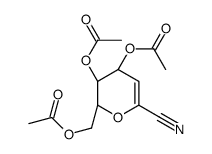4,5,7-TRI-O-ACETYL-2,6-ANHYDRO-3-DEOXY-D-ARABINO-HEPT-2-ENONONITRILE,
Modify Date: 2024-02-06 12:19:10

4,5,7-TRI-O-ACETYL-2,6-ANHYDRO-3-DEOXY-D-ARABINO-HEPT-2-ENONONITRILE, structure
|
Common Name | 4,5,7-TRI-O-ACETYL-2,6-ANHYDRO-3-DEOXY-D-ARABINO-HEPT-2-ENONONITRILE, | ||
|---|---|---|---|---|
| CAS Number | 120085-62-3 | Molecular Weight | 297.26100 | |
| Density | 1.29g/cm3 | Boiling Point | 397.8ºC at 760mmHg | |
| Molecular Formula | C13H15NO7 | Melting Point | N/A | |
| MSDS | N/A | Flash Point | 174ºC | |
| Name | [(2R,3S,4R)-3,4-diacetyloxy-6-cyano-3,4-dihydro-2H-pyran-2-yl]methyl acetate |
|---|---|
| Synonym | More Synonyms |
| Density | 1.29g/cm3 |
|---|---|
| Boiling Point | 397.8ºC at 760mmHg |
| Molecular Formula | C13H15NO7 |
| Molecular Weight | 297.26100 |
| Flash Point | 174ºC |
| Exact Mass | 297.08500 |
| PSA | 111.92000 |
| LogP | 0.21918 |
| Vapour Pressure | 1.54E-06mmHg at 25°C |
| Index of Refraction | 1.497 |
Synonym: Section 2 - COMPOSITION, INFORMATION ON INGREDIENTS
Risk Phrases: None Listed. Section 3 - HAZARDS IDENTIFICATION EMERGENCY OVERVIEW
Not available. Potential Health Effects Eye: May cause eye irritation. Skin: May cause skin irritation. May be harmful if absorbed through the skin. Ingestion: May cause irritation of the digestive tract. May be harmful if swallowed. Inhalation: May cause respiratory tract irritation. May be harmful if inhaled. Chronic: Not available. Section 4 - FIRST AID MEASURES Eyes: Flush eyes with plenty of water for at least 15 minutes, occasionally lifting the upper and lower eyelids. Get medical aid. Skin: Get medical aid. Flush skin with plenty of water for at least 15 minutes while removing contaminated clothing and shoes. Ingestion: Get medical aid. Wash mouth out with water. Inhalation: Remove from exposure and move to fresh air immediately. Notes to Physician: Treat symptomatically and supportively. Section 5 - FIRE FIGHTING MEASURES General Information: As in any fire, wear a self-contained breathing apparatus in pressure-demand, MSHA/NIOSH (approved or equivalent), and full protective gear. Extinguishing Media: Use water spray, dry chemical, carbon dioxide, or chemical foam. Section 6 - ACCIDENTAL RELEASE MEASURES General Information: Use proper personal protective equipment as indicated in Section 8. Spills/Leaks: Absorb spill with inert material (e.g. vermiculite, sand or earth), then place in suitable container. Vacuum or sweep up material and place into a suitable disposal container. Section 7 - HANDLING and STORAGE Handling: Avoid breathing dust, vapor, mist, or gas. Avoid contact with skin and eyes. Storage: Store in a cool, dry place. Store in a tightly closed container. Section 8 - EXPOSURE CONTROLS, PERSONAL PROTECTION Engineering Controls: Use adequate ventilation to keep airborne concentrations low. Exposure Limits CAS# 120085-62-3: Personal Protective Equipment Eyes: Not available. Skin: Wear appropriate protective gloves to prevent skin exposure. Clothing: Wear appropriate protective clothing to prevent skin exposure. Respirators: Follow the OSHA respirator regulations found in 29 CFR 1910.134 or European Standard EN 149. Use a NIOSH/MSHA or European Standard EN 149 approved respirator if exposure limits are exceeded or if irritation or other symptoms are experienced. Section 9 - PHYSICAL AND CHEMICAL PROPERTIES Physical State: Solid or liquid Color: Not available. Odor: Not available. pH: Not available. Vapor Pressure: Not available. Viscosity: Not available. Boiling Point: Not available. Freezing/Melting Point: Not available. Autoignition Temperature: Not available. Flash Point: Not available. Explosion Limits, lower: Not available. Explosion Limits, upper: Not available. Decomposition Temperature: Solubility in water: Specific Gravity/Density: Molecular Formula: C13H15NO7 Molecular Weight: 297.26 Section 10 - STABILITY AND REACTIVITY Chemical Stability: Not available. Conditions to Avoid: Incompatible materials. Incompatibilities with Other Materials: Strong oxidizing agents. Hazardous Decomposition Products: Carbon monoxide, oxides of nitrogen, carbon dioxide. Hazardous Polymerization: Has not been reported Section 11 - TOXICOLOGICAL INFORMATION RTECS#: CAS# 120085-62-3 unlisted. LD50/LC50: Not available. Carcinogenicity: 4,5,7-Tri-O-acetyl-2,6-anhydro-3-deoxy-D-a rabino-hept-2-enononitrile - Not listed by ACGIH, IARC, or NTP. Section 12 - ECOLOGICAL INFORMATION Section 13 - DISPOSAL CONSIDERATIONS Dispose of in a manner consistent with federal, state, and local regulations. Section 14 - TRANSPORT INFORMATION IATA Not regulated as a hazardous material. IMO Not regulated as a hazardous material. RID/ADR Not regulated as a hazardous material. Section 15 - REGULATORY INFORMATION European/International Regulations European Labeling in Accordance with EC Directives Hazard Symbols: Not available. Risk Phrases: Safety Phrases: S 24/25 Avoid contact with skin and eyes. WGK (Water Danger/Protection) CAS# 120085-62-3: No information available. Canada None of the chemicals in this product are listed on the DSL/NDSL list. CAS# 120085-62-3 is not listed on Canada's Ingredient Disclosure List. US FEDERAL TSCA CAS# 120085-62-3 is not listed on the TSCA inventory. It is for research and development use only. SECTION 16 - ADDITIONAL INFORMATION N/A |
| Safety Phrases | S24/25 |
|---|
| 4,5,7-Tri-O-acetyl-2,6-anhydro-3-deoxy-D-arabino-hept-2-enononitrile |
| 3,4,6-tri-O-acetyl-1-cyano-D-glucal |
| 4,5,7-tri-O-acetyl-2,6-anhydro-3-deoxy-D-arabino-hept-2-enonitrile |
| 4,5,7-Tri-O-acetyl-2,6-anhydro-3-deoxy-2,3-didehydro-D-arabino-heptononitrile |
| (2R,3R,4R)-4-acetyloxy-2-(acetyloxymethyl)-6-cyano-2H-3,4-dihydropyran-3-yl ac etate |